This sounds like a solution to me, it makes sense in my head at least although i would need help in identifying which of the 4 wires coming into the box i need to use as well as the wiring of the relay and diodes mentioned! As for the receiver it is a plug in receiver and as the doorbell is in the hall with a direct run through the kitchen all that is between my desk and the doorbell is the glass of the back door then 8M to the wooden office again with a lot of glass across the front. I have tested the bell as it stands from the front door and it rings every time in the office.The relay ensures wireless transmitter dc voltage never gets mixed with bells AC voltage. and a relay can operate with just a single diode rectifier and capacitor.
OP, if you need a schematic drawing how to do it just give us a shout.
(bear in mind wireless door bells have tendency to be unreliable as the distance becomes greater, the range suffers, so you may even have to place the transmitter mid way in your home for it to reach your outbuilding office.) 100m range is specified in clear field, usually they have problem even at 20m range indoors through walls and general building layout.)
If you could help with a list of parts and wiring i would be very grateful.


